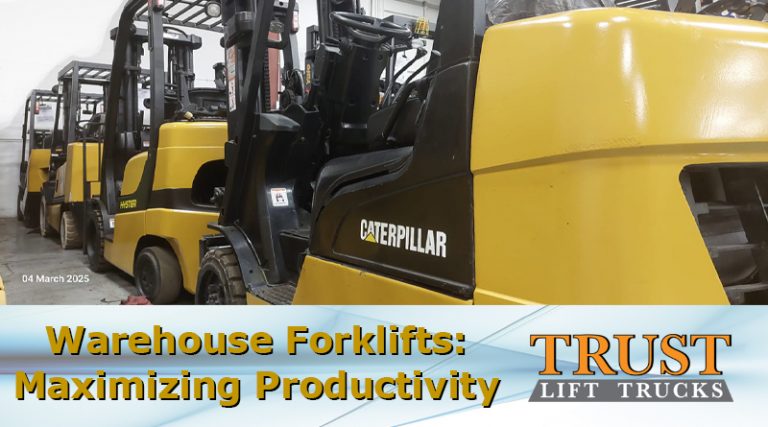Warehouse Forklifts: Maximizing Productivity

Warehouses are bustling environments where every second counts. The backbone of any efficient warehouse operation is its fleet of warehouse forklifts. These versatile machines are indispensable for moving goods, organizing inventory, and ensuring seamless workflows. When used to their full potential, forklifts can dramatically enhance productivity, safety, and cost-effectiveness. Let’s explore the strategies to maximize the impact of forklifts in warehouse operations and quantify the productivity gains they deliver.
1. Choosing the Right Forklift
The journey to maximizing forklift productivity begins with selecting the right equipment. Warehouses vary in size, layout, and function, and so do forklifts. Counterbalance forklifts, for example, are perfect for heavier loads and general-purpose tasks. When using this type of forklifts choosing the right mast size should not be neglected. Reach forklifts, on the other hand, are essential for navigating tight spaces and accessing high shelves. Pallet jacks or walkie stackers are ideal for smaller warehouses or compact areas. By assessing your specific needs and investing in suitable machinery, you can minimize inefficiencies and reduce unnecessary wear on equipment.
Customization is another game-changer. Forklifts can be equipped with specialized attachments such as clamps, extensions, or even drum handlers to handle unique loads. This adaptability further boosts productivity by enabling businesses to tackle a wider range of tasks with the same equipment.
On average, choosing the right warehouse forklifts can improve productivity in material handling tasks by up to 30%, as operations are streamlined and suited to specific needs.
2. Prioritizing Comprehensive Training
A forklift’s true potential is unlocked by its operator. Skilled and confident operators are key to achieving operational efficiency and ensuring workplace safety. Comprehensive training programs go beyond basic operation to cover topics such as load balancing, maneuvering in tight spaces, and emergency protocols.
Trained operators are more likely to complete tasks quickly without errors, which saves time and reduces the risk of accidents. This, in turn, minimizes downtime caused by damaged goods or injuries. Additionally, fostering a culture of continued education ensures that operators stay updated on best practices and new technologies, leading to sustained productivity gains.
Proper operator training can lead to productivity improvements of 20% to 40% by reducing errors and ensuring smooth operations.
3. Leveraging Technology and Automation
Technology has redefined how warehouse forklifts contribute to warehouse efficiency. Modern forklifts are increasingly equipped with smart systems, such as GPS tracking, collision detection, and automated navigation. These features allow operators and managers to streamline operations, optimize travel routes, and reduce energy consumption.
Telematics systems provide real-time insights into forklift performance, fuel usage, and maintenance needs. By analyzing this data, businesses can identify bottlenecks, schedule maintenance proactively, and make data-driven decisions to enhance productivity. Automation, such as self-guided forklifts, is another promising frontier that reduces reliance on manual labor for repetitive tasks.
Implementing advanced technology and automation can further enhance productivity by an additional 10% to 15%, particularly in high-demand operations.
4. Maintaining Forklift Health
Maintenance is often overlooked but critical for sustaining productivity. A poorly maintained warehouse forklift is more prone to breakdowns, leading to costly delays. Implementing a robust maintenance schedule ensures that forklifts operate reliably and efficiently. Regular inspections, proper lubrication, and timely replacement of worn parts such as tires extend the lifespan of equipment and prevent sudden failures.
Using diagnostic tools and condition-monitoring systems can further enhance maintenance practices. These technologies allow technicians to predict and address potential issues before they escalate, ensuring forklifts are always ready to perform. Regular maintenance can prevent unplanned downtimes and sustain productivity levels, saving warehouses from potential delays and losses.
5. Optimizing Warehouse Layout
The layout of a warehouse plays a pivotal role in forklift efficiency. Wide, well-marked aisles allow forklifts to navigate seamlessly without collisions or bottlenecks. Grouping items based on their demand frequency—commonly referred to as ABC analysis—reduces the time forklifts spend traveling between shelves and loading docks.
Strategically positioned storage racks and loading zones also minimize unnecessary movement. An organized warehouse layout not only speeds up operations but also enhances safety by reducing clutter and congestion.
Well-thought-out layouts, when paired with forklifts, can improve overall warehouse efficiency by as much as 20%.
6. Embracing Sustainability
As environmental concerns rise, electric forklifts are gaining popularity for their eco-friendly and cost-effective advantages. Unlike internal combustion forklifts, electric models produce zero emissions, making them a cleaner option for indoor operations. These forklifts are also quieter, reducing noise pollution in the warehouse.
To further boost sustainability, businesses can adopt energy-efficient practices such as smart charging schedules or regenerative braking systems. By aligning productivity with environmental goals, warehouses can achieve a win-win scenario.
Quantifying the Benefits
Studies and case reports estimate that integrating forklifts into warehouse operations and optimizing their usage can result in an overall productivity boost of 20% to 50%. These gains stem from faster transport times, reduced manual labor, and smarter use of resources through advanced technologies and training.
Conclusion
Warehouse forklifts are more than just machines—they are productivity powerhouses. By choosing the right equipment, prioritizing operator training, integrating technology, maintaining equipment health, and optimizing warehouse layouts, businesses can unlock the full potential of their forklifts. In doing so, they create a workplace that is not only efficient and safe but also adaptable to future challenges.
Please be reminded that Trust Lift Trucks knowledgeable staff are ready to assist you in selecting the right strategy according to your specific applications. Both the propane and electric forklift fully refurbished are available for your warehouse. We are just a call away from you in Toronto and GTA.
